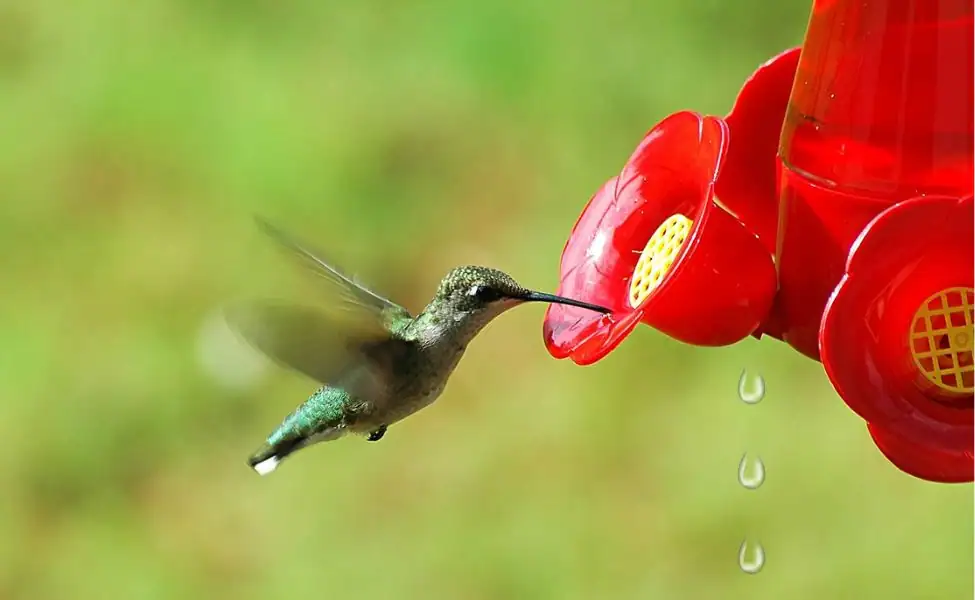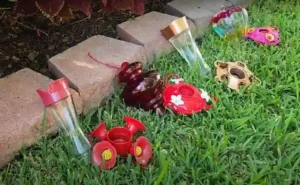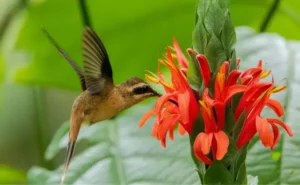Looking for a solution for hummingbird feeder leaking?
You must be excited about setting up a hummingbird feeder in your garden but ended up being frustrated because of nectar leaking from the feeder. It’s annoying, right? Whether you’re a hummingbird enthusiast or just someone who enjoys watching those glittering hummingbirds flit around with a leaky feeder can be disappointing.
Leaky feeders can attract abundant ants and bees but cause many problems for hummingbirds. Instead of peacefully enjoying a snack, they navigate a sticky mess. If you have a lot of feeders that tend to leak all the nectar overnight, then don’t worry; turning your garden into a hummingbird haven is still very much on the table.
Understanding the causes of leakage and implementing preventative measures can help maintain a functional and efficient hummingbird feeder. There are ways to minimize leaks and make your garden a welcoming environment for these tiny birds.
Table of Contents
Causes of Hummingbird Feeder Leaking
If the hummingbird feeders in your garden are dropping tiny drips that might seem small, they can frustrate both you and the hummingbirds. I was happy to see plenty of hummingbirds in my garden, but suddenly, I noticed that one of my feeders was dripping from the flowers.
I wondered, why is my hummingbird feeder leaking from the flowers? Then I found several common reasons of feeder leaking. Here are some of the causes that you must consider:
- The incorrect positioning of the feeder may cause the leakage. The wind may tilt it, or it may be leaning against something.
- Improper assembly of the feeder can also cause nectar to leak. If the parts of the feeder aren’t put together tightly, there might be little cracks and gaps. Double-check that everything is screwed on nicely and snugly, making sure all the seals are in place.
- Sometimes, even the robust feeders can get little cracks or breaks. If there’s a tiny crack, especially near the flowers, the nectar will surely drip out of it.
- Issues with the stopper or seals can also cause the leakage. The stopper at the top is like a lid on a jar it keeps the nectar fresh and trapped inside the hummingbird feeder.
- Too much wind or sunlight can make the feeder leak. When the sun heats the air above the nectar, it expands and pushes the nectar out of the ports. It’s like the nectar is trying to escape because it gets too hot up there.
- Leaking can be caused by improper cleaning, damaged seals, or design flaws.
Ways to Prevent Feeders from Leaking
Just like you wouldn’t want to sip a steaming latte in the blazing sun, neither do our feathered friends like their nectar getting warm and fussy. Mounting your feeder in the shade or popping on a nifty Hummer Helmet helps keep things cool and prevents leaks from pressure buildup.
The birds aren’t known for their graceful landings. So, keeping your feeder out of the wind’s way helps prevent spills. Find a calm spot where hummingbirds can safely enjoy the nectar.
Tube-style feeders work best when they’re full of delicious nectar. Keep your tube-style feeders full. Hummingbirds need a constant supply of nectar, and a full feeder ensures they won’t be disappointed when they stop by for a sip.
Invert and plug the stopper immediately after filling. Regularly check for cracks and replace cracked feeders. Regularly inspect and clean feeders to prevent debris from clogging the feeding holes. You can use hummingbird feeder brushes for thorough cleaning. Occasionally, use a vinegar rinse for more thorough cleaning.
1. Check the Seal
If you notice your hummingbird feeder dripping from its flowers, it’s probably because there’s an issue with the seal. First of all, you must check the rubber seal or gasket. The seal maintains a connection between the feeder’s bottle and the base.
It keeps nectar safely inside the feeder. Take a close look to ensure it’s properly aligned and free from any debris. If you notice any damage or wear and tear, it’s time to replace it with a new seal.
2. Fix the Loose Cups
How to fix a leaking hummingbird feeder they typically leak right where the cup meets this tube and you’re going to lose all your sugar water. Once I encountered the same issue that I’m gonna share here. Usually, the bottom of the cup is sealed onto the tube of the feeder.
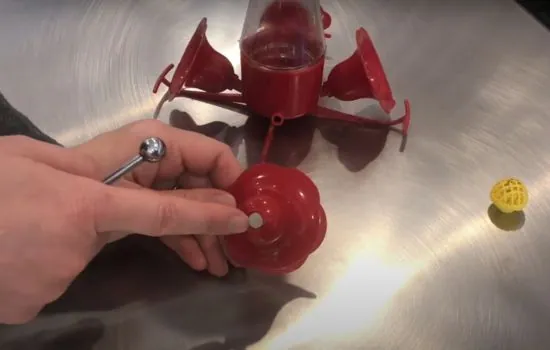
But the water was leaking from that part. It’s super important to check the cup off and on whether it’s leaking or not. The cups are made of polyethylene plastic which means glue does not stick to it. I took the stopper of the tube apart, then the cup that fits right onto the tube.
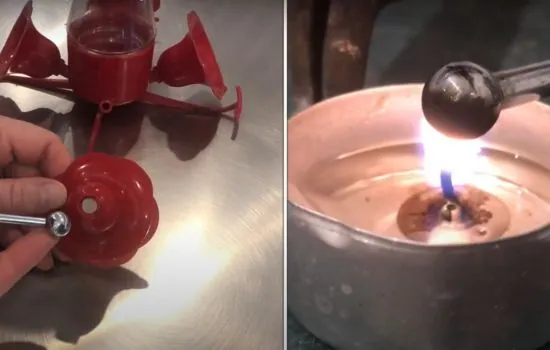
There, I noticed that the hole right down became loose and the water dripped right out of it. I heated something like a metal ball and pressed the plastic and made that hole just a little bit smaller. The method did work where I pressed both sides with some metal ball and got that hole a little bit smaller. Eventually, the cup was fixed onto the tube tightly and nectar leakage was stopped.
3. Adjust the Feeder Position
The positioning of your feeder plays a significant role in preventing leaks. Ensure that the feeder is level and not tilting or leaning in any direction.
You must also check if the feeder is in direct sunlight for extended periods, as heat can cause expansion and it lead to the nectar overflowing from the feeder. So, you have to move the feeder to a shaded area or use a protective cover to prevent it from heating in direct sunlight.
4. Clean the Feeder Regularly
Hummingbird feeders can leak due to residue from nectar, mold, or debris causing clogs and leaks. It is essential to clean the feeder regularly with hot water and a mild detergent. Additionally, it is recommended to use a bottle brush or a pipe cleaner to remove any buildup that may have occurred in the feeding ports.
It is essential to thoroughly rinse the feeder before refilling it with new nectar. Sometimes a good cleaning of the feeder holes with a toothpick works. The hummingbirds like having a clean feeding area, and maintaining a regular cleaning schedule not only keeps them happy but also prevents those unpleasant leaks from occurring.
5. Reduce Nectar Level
The issue of hummingbird feeders leaking can be linked to overfilling of the feeder, which can lead to leaks, especially during temperature changes. To prevent this, it is recommended to reduce the nectar level and fill the feeder only about two-thirds full to allow for expansion without leakage.
It is also important to monitor the nectar level daily and adjusting it accordingly to prevent overflow can also help prevent leakage.
6. Consider Dripless Feeders
The dripless feeders for hummingbirds are designed to prevent leaks and spills, keeping the nectar contained and reducing waste. These feeders are designed to be dripless and provide plenty of nectar to hummingbirds. They are made from metal and glass and feature multiple capacities and colors. The feeders can be filled with cool nectar to minimize dripping.
No-drip hummingbird feeders are also easier to maintain and keep clean, reducing the risk of mold growth. Additionally, high-quality dripless feeders, such as glass or metal ones, can be more durable and long-lasting compared to low-quality plastic feeders.
You can opt for well-designed dripless hummingbird feeders with built-in ant moats. Saucer-style feeders can be particularly effective in preventing nectar from leaking. These feeders hold nectar below the feeding ports.
7. Choose High-Quality Feeders
One of the best solutions to prevent leaking is to invest in high-quality feeders. Low-quality hummingbird feeders are everywhere. I have experienced leakage due to poor gaskets or defective parts in certain feeders.
Low-quality feeders with poor gaskets or defective parts are prone to leaking, causing frustration and attracting unwanted pests. There are some factors like temperature and pressure that can contribute to leakage, so it’s important to maintain the feeder properly. You can also use a tray feeder. Tray feeders do not leak.
Tray feeders for hummingbirds can be effective in attracting these birds, especially those that prefer perching while feeding. Feeder accessories like bee guards and flower ports are high-quality hummingbird feeders.
Common Mistakes to Avoid
If you’ve got a hummingbird feeder and are tired of dealing with leaks, then you should be aware of common mistakes that cause the feeders to leak. Here are some of the common mistakes listed below:
- Direct Sunlight: Most of the time, leaks happen when the feeder gets a bit too much sun. When the air inside the nectar bottle heats up, it expands and pushes the nectar out through the ports. So, hang the feeders in direct sunlight.
- No Ventilation: If the air pressure inside your hummingbird feeder goes a little higher, it can make a mess. But don’t worry; make sure your feeder has some holes for ventilation. This helps the air move around, stops pressure from building up, and keeps your feeder from leaking
- Poor Seal or Loose Parts: Insufficient sealing or loose components can result in air entering the feeder, causing changes in pressure. It will cause leakage. So, avoid using feeders with leaked parts.
- Overfilling the Feeder: This can lead to overflow and leakage, especially during temperature changes. Fill the feeder with an amount that the hummingbirds can consume within a few days.
Choosing Low-Quality Feeders: Many people use low-quality feeders just to save a few bucks, but they end up being frustrated because of leakage problems. You should invest in high-quality feeders with effective sealing mechanisms and proper ventilation.
Conclusion
It can be exhausting to deal with hummingbird feeders that leak. By following these tips and guidelines, you can successfully fix the problem and make sure the hummingbirds can eat without any leaks. Proper maintenance and adjustments can help resolve leaking issues. Reducing exposure to direct sunlight and wind can also minimize leakage.
Hummingbird feeders can sometimes leak from the flowers, causing a mess and potentially attracting unwanted insects. Understanding the causes of why hummingbird feeders leak and implementing preventative measures can help maintain a functional and efficient hummingbird feeder.

